
Is Mass Incarceration the Moral Equivalent of Slavery? Inquiring into and Arguing the Intersection of American Criminal Justice and Race History
Partner schools of Argument-Centered Education are taking up the issue of mass incarceration in the United States in their argument-centered social science and civics classrooms. Here’s how they’re doing it.
Overview
The United States – as President Barack Obama famously noted in a 2015 speech to the National Association for the Advancement of Colored People (the NAACP) – has 5% of the world’s population but about 25% of the world’s prisoners. The American prison population went from 300,000 in 1972 to 2.4 million in 2016, according to Amnesty International. What’s more, nearly 40% of the people in prison in this country are African-American, even though only 13% of Americans are black. It is statistics like these that have fueled an interest in and criticism of what has come to be called the phenomenon of mass incarceration. Books such as Douglas Blackmon’s Slavery by Another Name and Michelle Alexander’s The New Jim Crow, and the recent HBO documentary “13th” (directed by Ava DuVernay) view mass incarceration as part of the long history of racism in this country, and even see the mass imprisonment of African-Americans as a kind of re-enslavement – a stripping of freedom, an institutionalized control, a total domination – of black people. DuVernay highlights a point made by some legal scholars that the 13th Amendment to the U.S. Constitution, passed in 1865, commonly understood as the legal end of slavery, actually extends the legality of slavery in its “exception clause.” The substance of the 13th Amendment states simply:
Neither slavery nor involuntary servitude, except as a punishment for crime whereof the party shall have been duly convicted, shall exist within the United States.
These critics point to the racially coded “law and order” campaign of President Richard Nixon in the 1970s, and the “war on drugs” initiated by President Ronald Reagan in the 80s (and then extended and expanded by both political parties in the 90s), as being the levers of the criminal justice system that created mass incarceration and its resulting oppression of black men in America. They have argued that mass incarceration is, in effect, the moral equivalent of slavery.
But this critique of mass incarceration has elicited a significant response from a range of scholars, thinkers, and commentators. Recent books from university professors of law and sociology – John Pfaff’s Locked In and James Forman’s Locking Up Our Own, are prime examples – recognize a major problem in the size of the American prison population, but they disagree with an equation of mass incarceration and slavery. They argue that the war on drugs does not explain the explosive rise in imprisonment of African-Americans; the vast majority of prisoners are convicted of violent crimes. High percentages of African-Americans, they argue, were in support of tough anti-drug laws, in an era when crack cocaine was ravaging cities across the country. Other scholars dispute the historical accuracy of believing that the intention of the Congress in passing the 13th Amendment was anything other than ending slavery (while allowing for the incarceration of convicted criminals of any race). And some state that slavery was so horrific that to equate the imprisonment of convicted criminals to the conditions of the enslavement of the all black peoples is, to put it mildly, illogical. These and other arguments have propelled a counter-interpretation of the state of mass incarceration.
This debate is at the cutting edge of 2017 discussions of the intersection of the criminal justice system and the history of racism in this country. Students can engage with the issue’s complexities, inquire about what the evidence and reasons say on all sides, interrogate and evaluate the strength of support for the competing arguments and counter-arguments, and ultimately stake out, express, and project their own position.
Debatable Issue
Is mass incarceration of African-Americans in the U.S. the moral equivalent of slavery?
Resources
This is a collection of resources that can be used with whatever argument-centered instructional activity or project you choose to implement.
The Media List includes an equal number of sources — textual, video, and blogged — to support arguments that mass incarceration is and that it is not the moral equivalent of slavery. The Media List is annotated, so that each source link is followed by a one to two sentence summary of the position and strongest argument made by the source. The opening section in the Media List has sources that provide some “neutral” background on the issue.
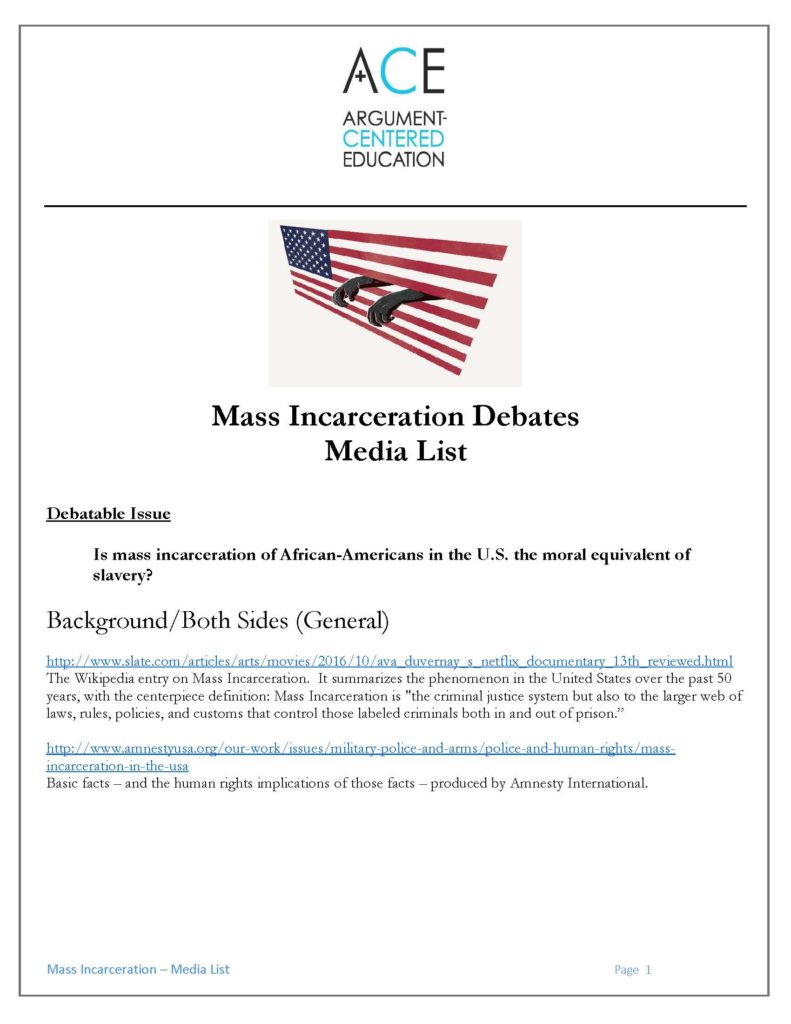
The Selected Evidence Set pulls one or two pieces of evidence from each of the sources on the Media List. Each piece of evidence supports a claim — a reason one of the overall positions is true — or a counter-claim — a reason that an opposing argument is not true. Those claims are not specified in the Selected Evidence Set, so students either formulate them themselves or you can give them options from the Possible Claims List. Each piece of evidence in the set is either quoted or paraphrased from the source. Evidence from the set does not need to be quoted or paraphrased in full; students using this set can use a portion of the evidence, or they can pull facts or information from the evidence, and still cite the source in their argumentation. Overall, the Selected Evidence Set is a scaffolding and modeling device. It is in Word format so that you can use it with students flexibly, on an as-needed basis.
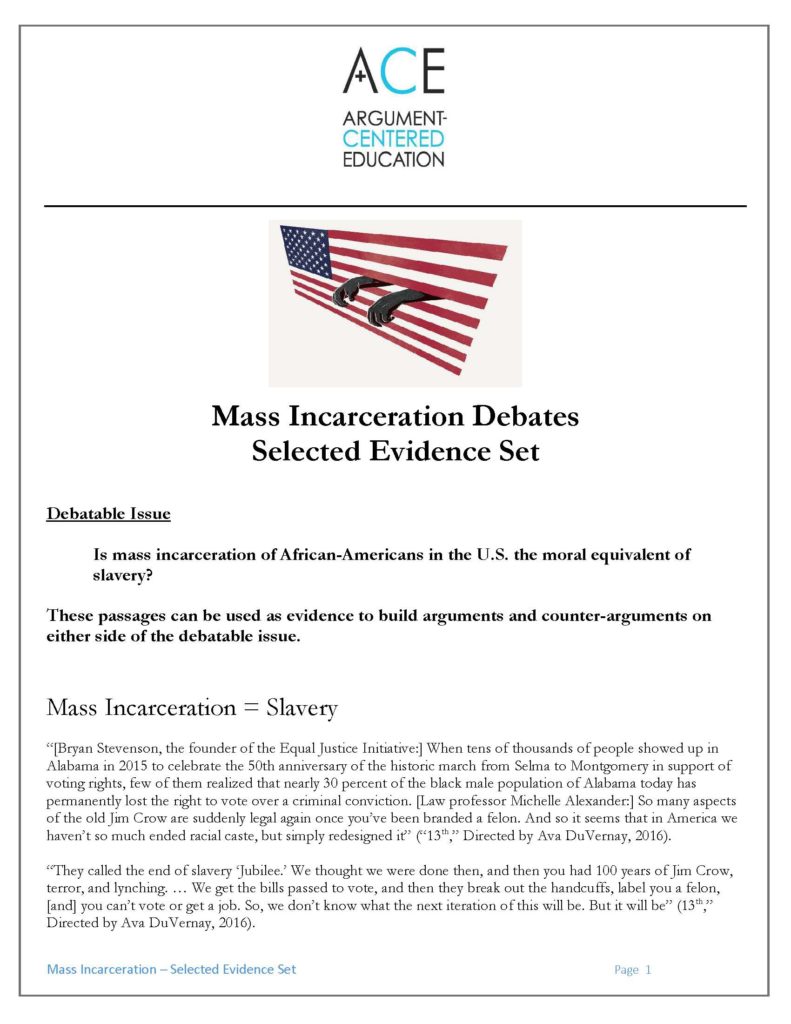
We have included a couple of infographics that students can use as evidence to support arguments or counter-arguments. Note that these infographics are not included on the Media List — they are additional to the Media List.

What follows are four short videos — all included in the Media List — on both sides of this debate on mass incarceration.
The Equal Justice Initiative produced a creative, artistically impressive 6 minute survey of the history of racism in this country, implicitly (and sometimes explicitly) drawing a linear connection from the beginning of North American slavery in 1619 to the current crisis of mass incarceration.
The website Vox.com posted a short video making the point that Federal mandatory minimum sentencing laws were harsh and racist and exploded the prison population.
The position that mass incarceration is the moral equivalent of slavery has to reckon itself with the true horrors of American slavery, from 1619 – 1865. This short educational video recounts how dehumanizing and violent plantation slavery really was.

One of the most devastating features of American slavery was the slave auction. Slaves were treated as bad as — or worse — than livestock, being fattened by their owners for sale, and inspected (sometimes with salacious intent) by prospective buyers. The worst part of the slave auction: the sale of little children to different owners than their parents. Cruelty hard to fathom. The relevance of this information to the issue is that it raises the bar very high on the position that mass incarceration is the moral equivalent of slavery.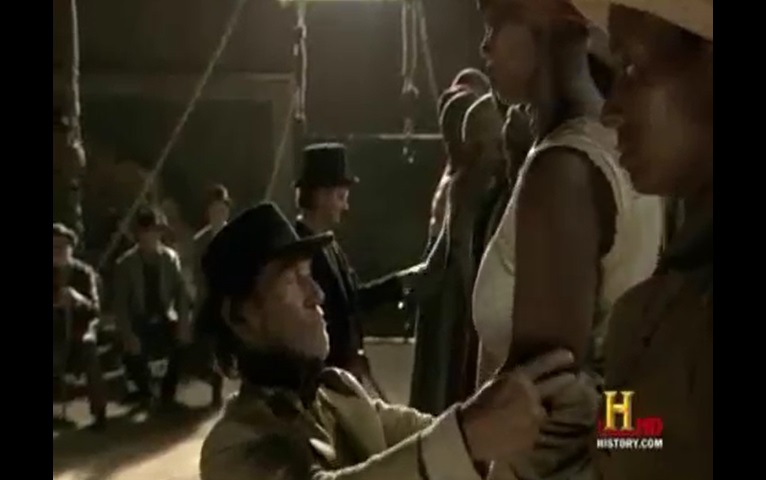
Students less experienced with academic argument find the structure of formulating argumentative claims that are subordinate to and supportive of an overall position a challenge at first. So we like to provide possible argumentative claims that can help you model and prod the kind of higher-order thinking that allows students to formulate and then develop strong claims.
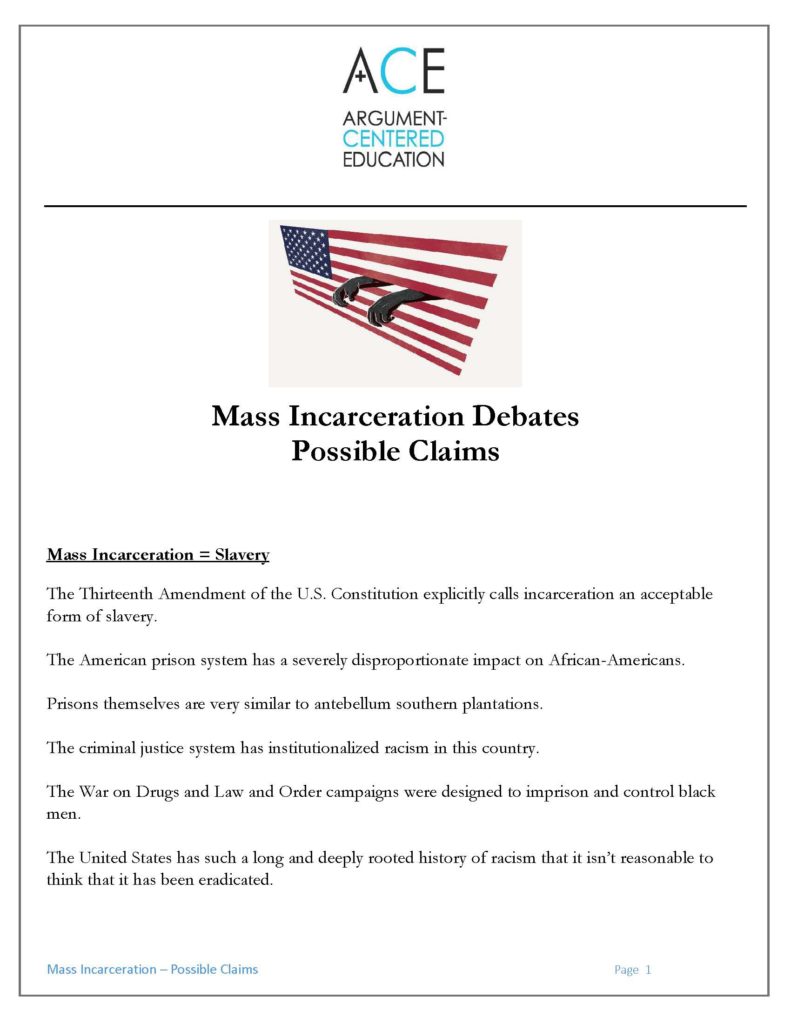
This instrument includes two possible counter-claims to each of the six argumentative claims offered on each side of the debatable issue. These counter-claims can be used to model counter-argument building, or they can be used in refutation activities, such as Refutation Two-Chance.

We have included an argument builder model and a counter-argument model on this issue. The argument model supports the mass incarceration is the moral equivalent of slavery position, and uses evidence from the Selected Evidence Set. This model demonstrates effective argumentative reasoning.
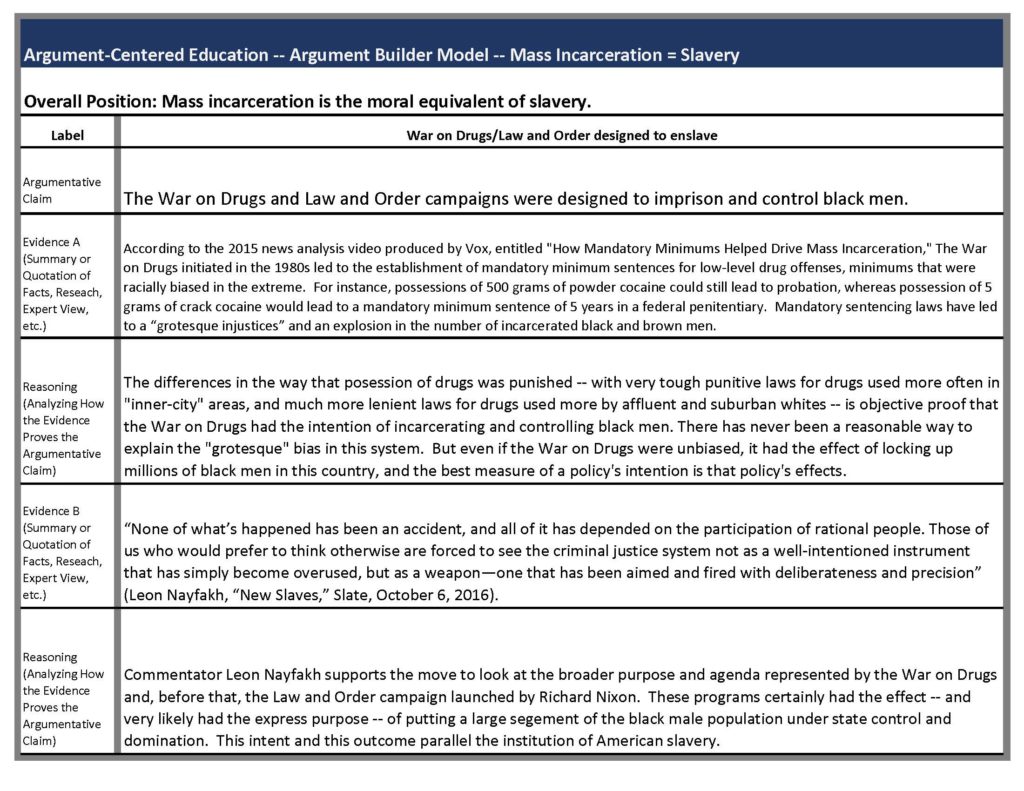
The counter-argument model includes an “independent counter-argument,” one with its own evidence and reasoning supporting a counter-claim, and a “critical counter-argument,” which through critique finds flaws with the evidence and reasoning of the argument to which it is responding.

Applications
As with other argument-centered units, there are a good number of argument-centered applications that can be used to engage students in the academic work students should be asked to do to activate and demonstrate their learning about mass incarceration.
Argument Essay
Students can simply be required to write an extended argument essay that requires them to put together their ideas and weigh in on the issue of mass incarceration.
Carefully read and annotate the attached set of secondary-source document excerpts. Use information from at least four of the sources in a coherent, well-developed essay that has an introduction, argumentative body, and conclusion. Your essay should take a clear position, stated in a thesis, on the issue. Your thesis should be supported and developed by 2 – 3 arguments. Each argument should have a claim, evidence, and reasoning, using one or two pieces of evidence from the set of sources. You should also address and refute at least one counter-argument, either in a separate paragraph or in your argument paragraphs.
Other Argument-Based Activities and Projects
Lucy Calkins and her colleagues, in her 2013 book The Research-Based Argument Essay, affirmed the value of conducting oral argumentation and debates in class prior to writing.
We’ve come to believe that it would be advantageous to students if we found opportunities throughout the day to immerse them in a culture of debate, or argumentation (in the best sense of the word). And we believe that it would invigorate the school day to find many opportunities, often, for students to take and defend positions, to learn from argument and counterargument. The research is clear that if students have opportunities to do the work orally that we hope they will learn to do as writers, this is advantageous to them.
These activities and projects can substantially improve and deepen students’ organization, critical thinking, use of evidence, and effectiveness in engaging with the other views and ideas on the issue. Or they can stand on their own as a summative assessment or unit project on the issue of mass incarceration.


Trackbacks for this post